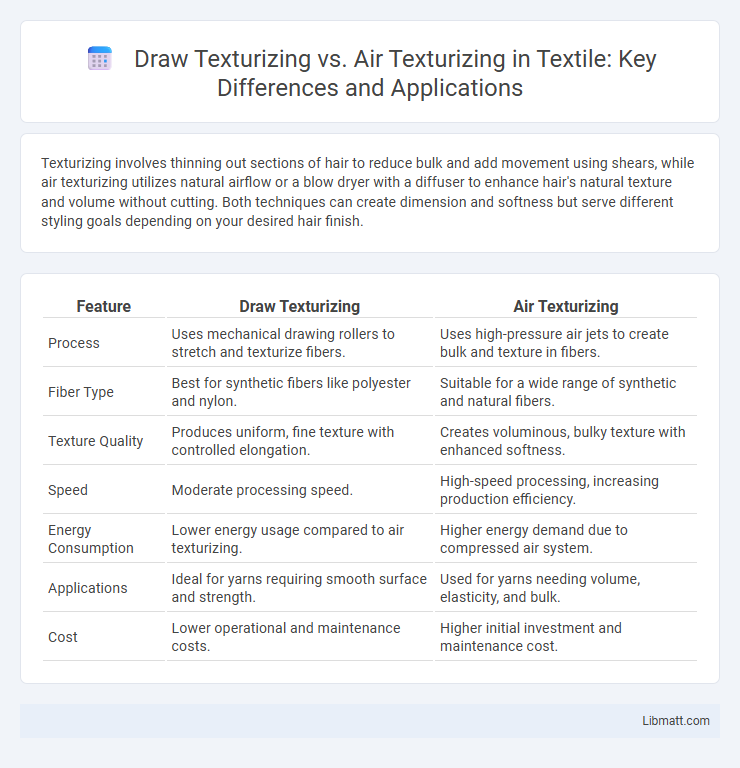Texturizing involves thinning out sections of hair to reduce bulk and add movement using shears, while air texturizing utilizes natural airflow or a blow dryer with a diffuser to enhance hair's natural texture and volume without cutting. Both techniques can create dimension and softness but serve different styling goals depending on your desired hair finish.
Table of Comparison
| Feature | Draw Texturizing | Air Texturizing |
|---|---|---|
| Process | Uses mechanical drawing rollers to stretch and texturize fibers. | Uses high-pressure air jets to create bulk and texture in fibers. |
| Fiber Type | Best for synthetic fibers like polyester and nylon. | Suitable for a wide range of synthetic and natural fibers. |
| Texture Quality | Produces uniform, fine texture with controlled elongation. | Creates voluminous, bulky texture with enhanced softness. |
| Speed | Moderate processing speed. | High-speed processing, increasing production efficiency. |
| Energy Consumption | Lower energy usage compared to air texturizing. | Higher energy demand due to compressed air system. |
| Applications | Ideal for yarns requiring smooth surface and strength. | Used for yarns needing volume, elasticity, and bulk. |
| Cost | Lower operational and maintenance costs. | Higher initial investment and maintenance cost. |
Introduction to Draw Texturizing and Air Texturizing
Draw Texturizing involves using specialized shears to selectively cut hair strands, creating controlled texture and reducing bulk. Air Texturizing utilizes compressed air to gently remove weight from sections of hair without cutting, preserving length while enhancing movement. Both techniques offer versatile solutions for adding dimension and softness to hairstyles.
Understanding the Purpose of Texturizing Yarns
Texturizing yarns enhances fabric elasticity, bulk, and insulation by altering the fiber's surface and structure through processes like draw texturizing and air texturizing. Draw texturizing combines drawing and texturizing in one step, improving yarn strength and consistent texture, while air texturizing uses compressed air to create bulkier, softer yarns ideal for stretch and comfort. Your choice between these methods depends on the desired fabric properties, such as durability or softness, aligning with specific textile applications.
Draw Texturizing: Process Overview
Draw texturizing involves pulling hair through a comb and cutting selected strands to reduce bulk while maintaining length, creating natural movement and softness. This technique is ideal for thick or coarse hair, offering controlled thinning without altering the overall hairstyle shape. Your stylist uses draw texturizing to enhance manageability and deliver a lightweight, textured finish.
Air Texturizing: Process Overview
Air texturizing involves using a patented air-driven tool that gently lifts and separates hair strands without causing damage or breakage, creating natural volume and movement. This process enhances texture by selectively removing bulk and blending different hair lengths, making it ideal for all hair types. Your hairstylist can customize the air texturizing technique to achieve soft, airy layers that maintain hair health and shine.
Key Differences Between Draw and Air Texturizing
Draw texturizing uses a metal hook to pull hair strands through a blade, creating more precise and controlled texture with minimal volume reduction. Air texturizing employs compressed air to gently remove bulk and add softness, preserving natural movement and enhancing hairlightness. Understanding these key differences helps you choose the best technique for achieving either definition or natural fluidity in your hairstyle.
Advantages of Draw Texturizing
Draw texturizing offers superior control over hair shaping by allowing precise removal of bulk without disrupting the hair's natural pattern, resulting in smoother, more polished styles. This technique preserves the integrity of the hair shaft, reducing frizz and split ends compared to air texturizing. Stylists favor draw texturizing for its ability to create clean, structured looks that enhance volume and movement while maintaining hair health.
Benefits of Air Texturizing
Air texturizing provides enhanced control over hair volume and movement by using compressed air to selectively remove bulk, resulting in a softer, more natural finish compared to draw texturizing. This technique reduces heat and mechanical stress on the hair, promoting improved hair health and minimized damage. Stylists achieve precise texturizing tailored to individual hair types, offering long-lasting, lightweight results with increased shine and manageability.
Applications of Draw Texturized Yarns
Draw texturized yarns find extensive applications in the production of stretchable and breathable fabrics used in activewear, hosiery, and lingerie, providing enhanced comfort and flexibility. Their improved bulk and elasticity make them ideal for seamless knitting and warp knitting, offering better garment fit and durability. The yarns are also popular in automotive textiles and home furnishings where texture and resilience are essential.
Uses of Air Texturized Yarns
Air texturized yarns are primarily used in hosiery, seamless garments, and sportswear due to their enhanced bulk, softness, and elasticity. These yarns improve fabric breathability and comfort, making them ideal for activewear and lingerie. You can achieve lightweight, airy textures with air texturized yarns, which are less suitable for heavy-duty textiles compared to draw texturized alternatives.
Choosing the Right Texturizing Method
Choosing the right texturizing method depends on your hair type and desired styling outcome. Draw texturizing is ideal for creating natural volume and removing bulk without harsh changes, making it suitable for thick, coarse hair. Air texturizing offers a softer, more blended effect by lifting strands with airflow, perfect for fine or delicate hair needing subtle texture enhancement.
Draw Texturizing vs Air Texturizing Infographic

 libmatt.com
libmatt.com